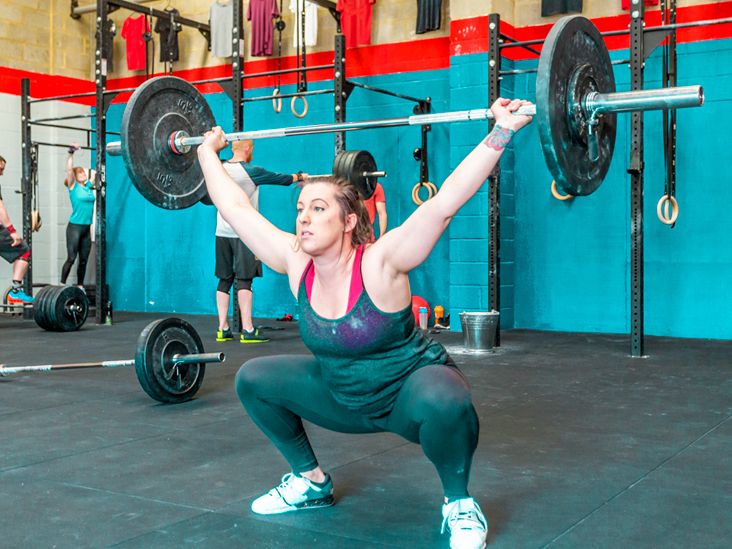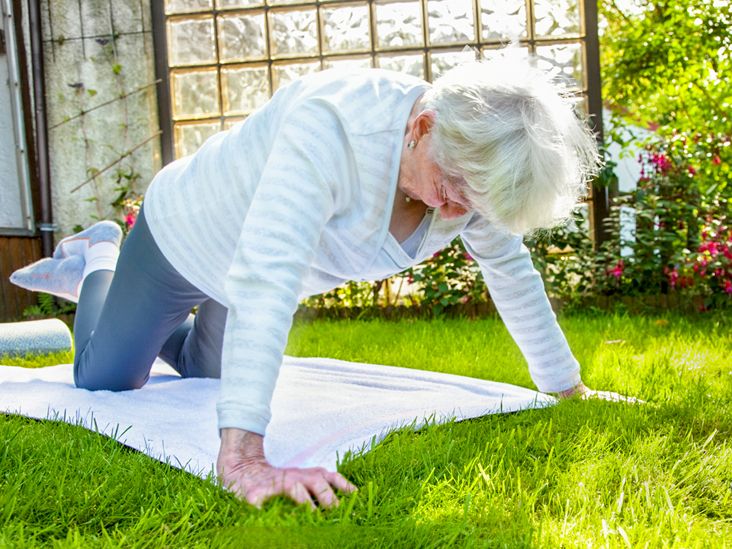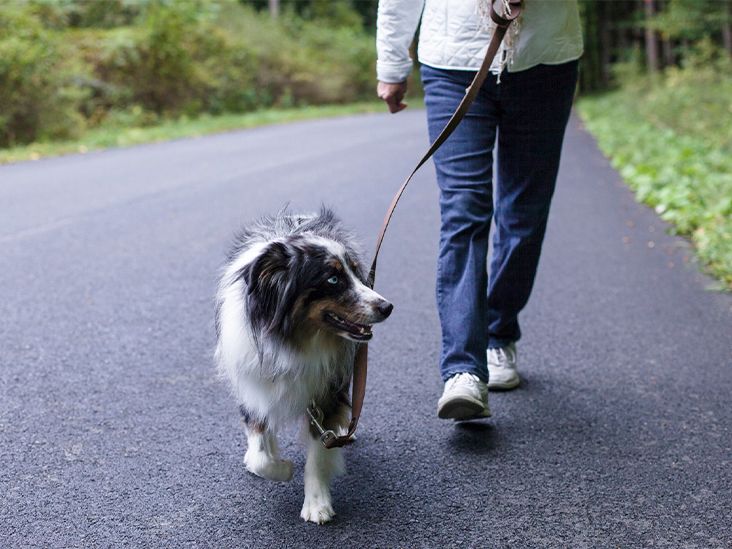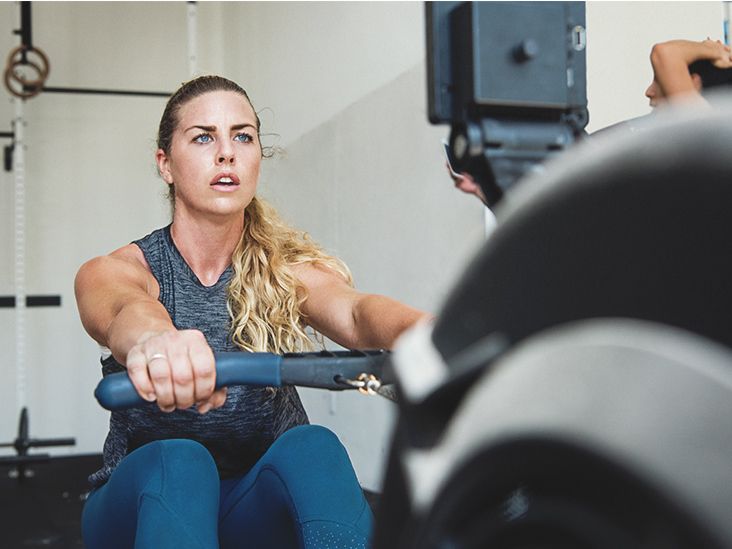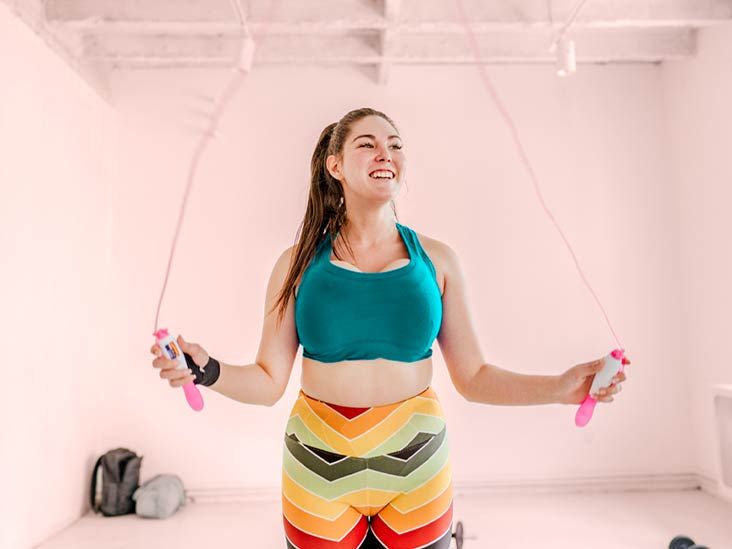Whether you head to an office or work from home, it’s important to be physically active every day.
Functional fitness can be a good way to prevent restlessness and keep your body moving.
What is functional fitness? It’s exercise that helps you with everyday activities such as:
- getting up off the floor
- carrying heavy objects
- putting something up on a shelf
By strengthening your muscles in the same way you would need to use them for certain everyday tasks, you reduce your risk of injury and increase your quality of life.
This means you can go through your day without worrying about straining or pulling something.
According to fitness expert Brad Schoenfeld, functional fitness “exists on a continuum.”
In his view, almost all exercise can be functional depending on the context, because increasing your strength will inherently help you become more functional in daily life.
While increasing your overall strength will help you move more fluidly, combining strength training with exercises that mirror the movements of daily activities can provide an even more effective training regimen.
It can also promote better:
- balance
- endurance
- flexibility
And who doesn’t want that, right?
We’ve compiled 13 exercises below that will help improve functional fitness for adults of all ages. Complete five or six of these exercises 3 or 4 days per week for the best results.
You can do them all safely at home with minimal equipment.
Squatting is similar to sitting in a chair, so it’s a must-have in any functional fitness routine.
Make sure your movements are slow and controlled. And if you need more of a challenge, hold a light dumbbell in each hand. To modify this movement, you can limit your range of motion so the depth of your squat works for your body.
Directions:
- Stand straight with your feet shoulder-width apart and your arms down at your sides.
- Bend your knees and start to squat down, pushing back into your hips, almost as if you’re about to sit in a chair. Raise your arms in front of you as you go.
- When your thighs are parallel to the floor, pause.
- Push through your heels to extend your legs and return to the starting position.
- Complete 2 sets of 15 reps.
Being able to push yourself up off the ground or another surface is invaluable in terms of functional fitness, but pushups can be very challenging.
The incline chest press works the same muscles and may be more beginner-friendly.
Directions:
- Position a bench at a 45-degree angle. Hold a dumbbell in each hand and lean back onto the bench. Extend your arms straight up so the dumbbells are above your head.
- Bend your arms, slowly lowering the weights toward your chest. Stop when your upper arms are just past parallel to the floor.
- Push the dumbbells back up to the starting position, using your pectoral muscles to lead the movement.
- Complete 2 sets of 15 reps.
Getting into and holding the plank position requires mobility and balance, which are helpful for getting up off the floor. Plus, the exercise uses many muscles, so it’s great for building overall strength.
Directions:
- Start on all fours with your palms planted on the floor and your knees bent slightly farther than 90 degrees.
- Push up through your hands and feet, extending your arms and legs, and keep your core tight. Your body should form a straight line from head to toe.
- Hold for as long as you can while maintaining proper form.
- Complete 2 sets.
If you need a bit more support than you would have in a typical squat, you can perform a squat against a wall. This should take any lower back pain out of the equation.
Directions:
- Stand with your back flat against a wall and your feet one step out from the wall.
- Bend your legs, pressing your back into the wall and allowing yourself to slide down into a squat.
- When your thighs are parallel to the floor, push back up against the wall to return to the starting position.
- Complete 2 sets of 15 reps.
Similar to getting down off a high seat or descending a set of stairs, step-downs are a great way to help improve balance and stability.
Directions:
- Stand next to a bench or step with one foot on the bench and one foot on the floor.
- Pushing through the heel of the foot on the bench, step up to extend your leg fully, then slowly lower back down to the starting position.
- Complete 2 sets of 15 reps on each side.
A row is a similar movement to taking a heavy object off a shelf. Targeting your back and arms will help you stay strong.
Directions:
- Attach a resistance band to an anchor slightly above your head. Sit in a chair, holding the handles so they’re taut.
- Pull your elbows down and back, pause for 1 second, and then release back to the starting position.
- Complete 2 sets of 15 reps.
In the split stance of a lunge, you’ll again mimic the movement of getting up off the ground. Strengthening your quadriceps, as well as promoting mobility in your knee joints, is crucial for completing daily activities.
Directions:
- Split your stance so that one leg is in front of the other.
- Without moving your feet, lunge forward on your front leg, stopping when your leg forms a 90-degree angle with the floor.
- Return to the starting position.
- Complete 2 sets of 15 reps on each side.
Strengthen the muscles you use to climb stairs with step-ups.
Directions:
- Stand with a bench or step in front of you — about one step away is good.
- Step up onto the bench with your right foot, only tapping your left foot to the surface while keeping your weight on your right foot.
- Step your left foot back down to the floor while keeping your right foot on the bench.
- Complete 2 sets of 15 reps on each leg.
Improving your balance makes everything easier, even walking. It also helps prevent falls.
Exercises performed in a single-leg stance are great for strengthening your core and leg stabilizers.
Directions:
- Stand with your feet together and your hands on your hips.
- With your weight on your left leg, hinge slightly forward at the hips while slowly raising your right leg straight back until it reaches a 45-degree angle.
- Return to the starting position.
- Complete 2 sets of 15 reps on your right leg, then repeat on your left leg.
Strengthening all parts of your core is key to functional fitness. Try a side plank to hit your obliques.
Directions:
- Lie on your side with your legs stacked, your lower arm bent at a 90-degree angle, and your weight resting on your forearm. Extend your other arm up toward the ceiling. You should look up toward the ceiling as well.
- Using your obliques, pull your midsection up off the floor, as high as it will go, and hold there for as long as you can.
- Turn to the other side and repeat.
- Complete 2 sets.
This yoga move requires you to support your body weight — a very useful skill for everyday life.
Directions:
- Start in a high plank position, with your weight in your hands and feet and your body forming a straight line from head to toe.
- Keeping your hands, feet, and neck stationary, pike your hips up so your body forms a triangle with the floor.
- Pause for 10 seconds.
- Repeat 2 more times.
Deadlifts are effective because they hit many of the muscles in your legs at once while helping you master the hip hinge.
Next time you go to pick something up off the ground, you’ll be happy that deadlifts are a part of your routine.
Directions:
- Stand with a dumbbell in each hand, resting the weights on your thighs.
- With a slight bend in your right leg, hinge at the hips and lift your left leg backward while keeping your back straight. The weights should slowly drop down in front of you, close to your body, as you go.
- Stop when you can no longer maintain your balance or when your left leg is parallel to the floor.
- Return to the starting position.
- Complete 15 reps, then repeat on the other leg.
Combining a lunge with a row requires an additional level of balance.
Directions:
- Hold a dumbbell in each hand and assume a lunge position.
- Hinge forward at the waist to a 45-degree angle and then row, pulling your elbows up and back.
- Release and return to the starting position.
- Complete 10 reps, then switch the position of your legs and complete 10 more reps. Do 2 sets.
Functional fitness can help improve your daily life by strengthening your muscles to prepare them for everyday tasks and activities. This form of strength training, which mostly uses your body weight, is simple and safe for almost anyone.
If you have any injuries, you should consult a doctor before trying this type of exercise.
In comparison to other popular forms of strength training, such as CrossFit and bodybuilding, functional fitness is much more laid-back, requiring less equipment and way less intensity.
The focus is on performance, not muscle size. And the risk of injury is significantly lower, which makes it suitable for people of all ages and experience levels.
Nicole Davis is a Boston-based writer, ACE-certified personal trainer, and health enthusiast who works to help women live stronger, healthier, happier lives. Her philosophy is to embrace your curves and create your fit — whatever that may be! She was featured in Oxygen magazine’s “Future of Fitness” in the June 2016 issue. Follow her on Instagram.





